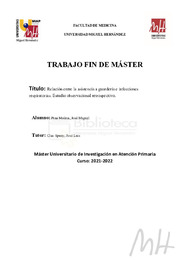Por favor, use este identificador para citar o enlazar este ítem:
https://hdl.handle.net/11000/27533Registro completo de metadatos
| Campo DC | Valor | Lengua/Idioma |
|---|---|---|
| dc.contributor.advisor | Clua Espuny, José Luis | - |
| dc.contributor.author | Pina Molina, José Miguel | - |
| dc.date.accessioned | 2022-07-25T17:06:08Z | - |
| dc.date.available | 2022-07-25T17:06:08Z | - |
| dc.date.created | 2022-06-27 | - |
| dc.identifier.uri | https://hdl.handle.net/11000/27533 | - |
| dc.description.abstract | Las infecciones respiratorias en la edad pediátrica (0-14 años) son en su mayoría de origen viral. Constituyen un factor de riesgo directo para padecer sibilancias en la época lactante (0-2 años) y asma en época escolar (6-10 años). La asistencia a guardería es un factor de riesgo indirecto relacionado con este hecho y descrito en multitud de estudios, aunque existen discrepancias, ya que en algunos trabajos lo describen como factor protector. Dado que las condiciones ambientales que encontramos en guarderías (clases cerradas, multitud de niños, interacción entre todos los alumnos...) favorecen la transmisión de los virus causantes de infecciones respiratorias y esto podría ser un factor de riesgo para desarrollar infecciones respiratorias de vías bajas y asma, podría existir una relación entre la asistencia a guardería y la incidencia de asma. | es_ES |
| dc.description.abstract | Infectious diseases occupy more than half of the reasons for consultation in pediatrics, highlighting respiratory infection (70%). Most cases are benign and affect the upper respiratory tract, although a not insignificant part (5%)(1) may involve the lower respiratory tract, being one of the most important causes of mortality in childhood worldwide( two) Respiratory infections in children (0-14 years) are mostly of viral origin (2). They constitute a direct risk factor for wheezing in the infancy (0-2 years)(3) and asthma in school (6-10 years)(4). Nursery attendance is an indirect risk factor related to this fact and described in many studies (3,5,6), although there are discrepancies, since some studies describe it as a protective factor. Given that the environmental conditions found in nurseries (closed classes, crowds of children, interaction between all the students...) favor the transmission of viruses that cause respiratory infections and this could be a risk factor for developing lower respiratory tract infections and asthma, there could be a relationship between child care attendance and the incidence of asthma. | es_ES |
| dc.format | application/pdf | es_ES |
| dc.format.extent | 23 p. | es_ES |
| dc.language.iso | spa | es_ES |
| dc.publisher | Universidad Miguel Hernández | es_ES |
| dc.rights | info:eu-repo/semantics/openAccess | es_ES |
| dc.rights | Attribution-NonCommercial-NoDerivatives 4.0 Internacional | * |
| dc.rights.uri | http://creativecommons.org/licenses/by-nc-nd/4.0/ | * |
| dc.subject | Sibilancias | es_ES |
| dc.subject | Asma | es_ES |
| dc.subject | Guardería | es_ES |
| dc.subject | Lactante | es_ES |
| dc.subject | Infancia | es_ES |
| dc.subject | Epidemiología | es_ES |
| dc.subject | Factor de riesgo | es_ES |
| dc.subject | Prevalencia | es_ES |
| dc.subject | Wheezing | es_ES |
| dc.subject | Asthma | es_ES |
| dc.subject | Nursery | es_ES |
| dc.subject | Epidemiology | es_ES |
| dc.subject | Risk factor | es_ES |
| dc.subject | Prevalence | es_ES |
| dc.subject.other | CDU::6 - Ciencias aplicadas::61 - Medicina | es_ES |
| dc.title | Relación entre la asistencia a la guardería e infecciones respiratorias. Estudio observacional restrospectivo. | es_ES |
| dc.type | info:eu-repo/semantics/masterThesis | es_ES |

Ver/Abrir:
PINA MOLINA, JOSÉ MIGUEL.pdf
419,87 kB
Adobe PDF
Compartir:
 La licencia se describe como: Atribución-NonComercial-NoDerivada 4.0 Internacional.
La licencia se describe como: Atribución-NonComercial-NoDerivada 4.0 Internacional.
.png)